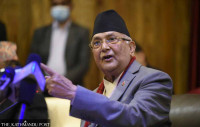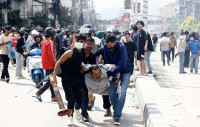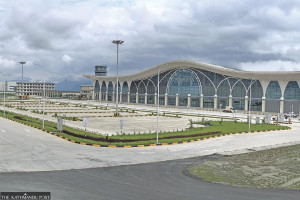Opinion
Back to the village
Migration is coded in our genes; people have always been moving around. The Out of Africa theory postulates that Homo sapiens migrated to the rest of the world around 70,000 years ago in search of food and a better life.
Pc Wasti
Migration is coded in our genes; people have always been moving around. The Out of Africa theory postulates that Homo sapiens migrated to the rest of the world around 70,000 years ago in search of food and a better life. In Nepal, people from the hills and mountains have been moving to the Tarai, and more recently, to the cities. The younger generation wants to migrate to the developed countries for a better education and higher standard of living.
Moving out
Migration is not always voluntary. Through history, people have been forced to migrate due to war or persecution. Not only in Kathmandu but other cities too, a massive influx of migrants has created chaos. Those with a good education try to get a job in the city and ultimately move there. Migrant workers returning from the Gulf and other countries buy land in the Tarai with their savings and settle there. Almost all the villages in Nepal now contain only women, children and the elderly. The youth, the energy of society, is absent. Without an active and energetic workforce, how can a country prosper, how can a society flourish?
Why people migrate is a million dollar question. In rural areas, in the hills and mountains, it is hard to get one square meal a day. The land, without irrigation facilities, does not produce enough food. If one migrates to the city, one can at least have a meal of rice daily. In the villages, one has to wait for a festival to eat meat; but in the cities, it is very easy to get any kind of meat. Hunger and malnutrition stalk the villages. Knowledge about nutrition is limited or nonexistent. Foods with very low nutritional value are widely consumed. Nutritious crops such as millet, barley, buckwheat and wheat are considered to be inferior. Legumes and pulses are produced, but not consumed in adequate quantities. They are sold to earn money to buy market foods. Milk and eggs are luxuries and are sold to buy household necessities. Green leafy vegetables are not valued much and fruits are not considered to be essential foods.
Families cannot afford child appropriate foods, so the young ones eat what the rest of the family eats. As a result, the children are malnourished and enter school with an inadequately developed brain. They can’t get good grades and can’t do well when they become adults. People, therefore, don’t want to live in rural areas, the hills or the mountains. We have been trying to bring the fruits of development to the villages. We have started making rural roads, supplying piped water, building schools and expanding health services. But these efforts have not been enough to stop the movement of people from villages to the cities.
Urgent change
Nepal has a new constitution, and a federal system and strong local governance has been envisaged. Against this backdrop, there has to be a paradigm shift in the development framework. We have been involved in the development business long enough. It’s time to make development work for the people. If development can’t bring happiness to people’s faces, it has no use. Health and happiness can be brought to the people by creating an environment where everyone gets proper care and nutrition during the first thousand days of life. This will allow them to grow up as healthy youths and healthy adults, have a good education and finally have a good livelihood.
It is urgent to reverse migration from the villages to the cities, and from the mountains and hills to the Tarai. Good roads, employment opportunities, adequate on-farm and off-farm incomes, quality education and better health care facilities are some of the ingredients of development which can attract youths to return to their own villages and live happily with their friends and families. There are already examples of industrious youths who have excelled in agriculture and agriculture related businesses. Off-season vegetables, fruit orchards, goat farming, poultry farming and dairy farming are some of the attractive businesses to entice youths back to their villages.
If the truth be told, cities are polluted, there is not enough drinking water, life is very mechanical, feelings are absent and there is a lack of social cohesion. Who wants to live in the cities if they can earn enough to feed their families, pay the school fees and pay the cost of health care when a family member falls sick? If local governments plan in time to increase food production, villages can become self-sufficient in food and attract youths to take up agriculture, livestock and related enterprises. This will allow them to earn a good income and they will be able to enjoy an improved quality of health and education.
The theme of this year’s World Food Day, which fell on October 16, was ‘Invest in Food Security and Rural Development, Change the Future of Migration’. The investments that are being made in food security and rural development can be instrumental in reversing current migration trends. We should all put our efforts into developing our villages. Let’s spare some time and think of our birthplace, our village so that villages become future attractions, and the flow of migration is reversed from urban to rural areas.
Wasti is the senior food research officer at the Department of Food Technology and Quality Control




 10.12°C Kathmandu
10.12°C Kathmandu










